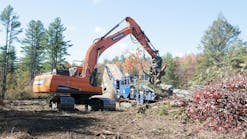Across the industry, a number of new excavator introductions resulted from last year’s mandate to meet the EPA’s Tier 3 exhaust emission regulations for machines of more than 175 gross horsepower. This year (2007) manufacturers will roll out Tier 3–compliant machines at the lower end of the scale. In their recent introductions, several manufacturers took the opportunity to boost power, improve cooling systems, and otherwise upgrade their excavators. This article summarizes excavator upgrades by Caterpillar, John Deere, Komatsu, Volvo, Hitachi, and Case Construction Equipment.
Caterpillar leads the way with four new midsize excavators, the 324D L, the 325D L, the 330D L, and the 328D LCR, which is a compact radius machine. Each of the four has more horsepower than the model it replaces. Engines on the four range from 188 horsepower on the 324D L up to 268 horsepower on the 330D L, which is 9% more than the 330C L. As well, a spacious new cab and new styling set the D-Series apart from previous machines.
Caterpillar says the new excavators deliver the lowest engine emissions ever through the use of ACERT technology. The company holds some 250 patents with ACERT, which lowers internal combustion temperatures by replacing one larger injection of fuel in the cylinder with multiple smaller injections. The result is a cooler burn and lowered emissions.
Of particular note is the Cat 328D LCR, which was introduced last June. This is a 76,500-pound excavator with 8% more engine horsepower and 2% more hydraulic pressure than the 325C LCR, which it replaces. In October we operated the 328D LCR at Caterpillar’s Arizona proving grounds and found it to be a strong excavating machine. The heavy lift circuit boosts working hydraulic pressure by 3%, says Jason Bowers, Caterpillar’s midsize excavator manager for North America.
“The new 328D compact radius excavator almost swings within its tracks,” says Bowers. “It’s ideal for road construction and underground utility projects in urban environments and confined spaces. For example, if you need to work up against a lane of traffic, the tail of the excavator won’t swing into traffic. And it has greater dump height to get an on-highway truck in closer than standard excavators can.”
Caterpillar’s D-Series excavators feature a wide range of factory-installed auxiliary hydraulic systems, including a one-way, high-pressure, high-flow circuit for hammers and vibratory plate compactors. Also, a two-way circuit is available for thumbs and other hydra-mechanical work tools. The Tool Control System is exclusive to Caterpillar and allows operators to set auxiliary hydraulic flows and pressures using a monitor in the cab instead of using expensive service tools. An operator can pre-set and store as many as 10 flow and pressure settings for 10 different hydraulic work tools.
Larger Machines In March of last year, John Deere rolled out its new D-Series excavators—six new models ranging from the 240D LC to the 850D LC. (On Deere machines the first two digits of the model number correspond approximately to the weight of the machine in metric tons.) Four members of the new D-Series—the 240D LC, the 350D LC, the 650D LC, and the 850D LC—are all somewhat larger than their predecessors.“We upsized several D models to make them more productive,” says Ryland Eichhorst, excavator engineering manager for John Deere’s Construction and Forestry Division. “For example, the 350D LC has 271 horsepower compared to 246 horsepower on the 330C LC. The 650D LC weighs 152,190 pounds and has 463 horsepower compared to 396 horsepower on the 600C. And the 850D LC went to 532 horsepower, up from 454 horsepower on the 800C.”
Eichhorst says the 240D, the 270D, and the 350D feature John Deere PowerTech engines and the 450D, 650D, and 850D have Isuzu engines. All engines meet Tier 3 requirements and the machines are supported by John Deere dealers across North America.
Deere says the totally redesigned cab—with its fully adjustable suspension seat and extra legroom—keeps operators comfortable and productive. The machines feature excellent visibility, with 47% more right-hand window glass and a larger roof-hatch area. Optimum hydraulic flows and pressures ensure powerful digging forces, precise control, and multifunction operation. Shorter pilot controls result in smooth, predictable control with less effort and fatigue.
John Deere’s D-Series models now have a remotely mounted hydraulically driven engine fan that runs only on cooling demand. The feature saves fuel and noticeably reduces noise in the cab, Eichhorst says. The engine radiator, hydraulic oil cooler, engine charge air cooler, and a small air-conditioning condenser are all located in this remotely mounted subframe away from the engine.
Plus, on the 240D, 270D, and 350D models, Deere offers an option by which the engine computer automatically reverses the engine fan every hour—to blow debris away from the machine. “That will help uptime,” says Eichhorst. “You don’t have to get off the machine to clean the radiator.” As well, the excavators permit the operator to manually reverse the fan on-demand. The reversing feature is manual-only on the 450D, the 650D, and the 850D machines but comes standard on those machines.
Upgrades at Komatsu Komatsu America Corp. last year introduced 10 new models across its excavator range, starting with the PC 200LC-8 and moving up to the PC 1250LC-8. All Komatsu excavators come standard with Komtrax, a global positioning system that transmits location, hour meter readings, and engine health back to the dealer’s office computer. It should be noted that John Deere and Caterpillar offer similar systems, called JD Link and Product Link respectively.Komatsu’s smaller models—below the PC 400—use an in-cylinder solution to meet Tier 3 requirements, says Peter Robson, senior product manager. The PC 400LC-7 and larger models use exhaust gas recirculation (EGR) systems. Except for Caterpillar’s ACERT system, most manufacturers employ EGR to meet emission rules.
Robson says the new PC 200, the PC 220, and the PC 270 all have a new cab with a 7-inch color monitor, which displays all key controls and working modes. “The monitor has all your functional controls, including your air conditioning and window wipers,” says Robson. “It’s very user friendly.
“We raised the bar on our attachment flow control,” says Robson. “Now you can change the flow to one-way or two-way from your monitor in the cab. You’ve got four pre-settable flows—two for one-way flow and two settings for two-way flow.”
Komatsu did not increase horsepower ratings with its Tier 3 excavators. “Our hydraulic systems are so smart that we can improve productivity and performance without increasing horsepower,” says Robson. “These are not bulldozers, where the extra power moves down to the tracks for more production. Plus, in today’s environment fuel economy is on the owner’s radar screen.”
Komatsu builds the engines, the hydraulic pumps, the valves, and the motors to work in synchronization with each other. “We control the matching of components in our hydraulic systems,” says Robson. “It’s a smart system that is very efficient.”
Operator’s cabs on Komatsu’s Dash 8 machines are “best-in-class quiet,” says Robson. “It’s an unforgettable difference between our machines and the competition,” he tells Grading & Excavation Contractor. And on the PC 300 and below, Komatsu has mounted a new mirror package for better around-the-machine visibility.
So what is Komatsu’s biggest edge? “Right now it’s fuel consumption and productivity,” says Robson. “I’ve been testing our machines versus the competition since the start of July [2006] and we’re just tickled pink with the results on our tests.”
Fuel Efficiency Important to Volvo Volvo last year rolled out six new Tier 3–compliant excavators, ranging from the EC240B LC up to the all-new EC700B LC. Conserving fuel is upper-most in the minds of Volvo officials, who increased hydraulic pump size and decreased engine revolutions per minute (rpms) on the 330, 360 and 460-size models, says Walter Reeves, product manager for excavators. Hydraulic power results from fluid pressure, and speed comes from flow volumes, Reeves says. “We put larger-displacement hydraulic pumps on the excavators to get the same flow at lower rpms,” he says.Volvo engines are more fuel efficient than most competitors, says Reeves. That’s because the engines achieve their highest torque ratings at less-than-full engine speeds. “For most excavators, the highest point on the torque curve comes at full-out rpms,” notes Reeves.
Volvo’s EC330B, EC360B, and EC460B machines all use the same 12-liter engine. Both the 330- and 360-sized excavators are rated at 265 horsepower, and the 460 is rated at 329 gross horsepower.The all-new EC700B LC is a 154,000-pound excavator aimed at competing with Caterpillar’s 365-sized machine. It was introduced in January 2006.Volvo has improved the cooling system on its EC240B and EC290B by placing the radiator and charge air cooler side by side, instead of stacking them. That makes maintenance and cleaning easier—plus, you don’t get heat transfer from the charge air cooler to the radiator, Reeves says.
The hydraulically driven engine cooling fan is controlled thermostatically so that it only runs on demand. “That way it saves fuel and doesn’t rob the engine of horsepower when it’s not needed,” Reeves says. “This is all to control fuel consumption. Tier 3 engines burn more fuel for everybody.”
Hitachi Adds Hydraulic Boosting SystemHitachi introduced a range of Tier 3–compliant excavators, including the Zaxis 270LC-3, the Zaxis 450LC-3, the Zaxis 650LC-3, and the Zaxis 850LC-3. All four machines feature Isuzu engines and Hitachi’s HIOS III hydraulic system. HIOS stands for “Human and Intelligent Operating System.”HIOS III has added two new components, Hitachi says: the hydraulic boosting system, which uses regenerative valves, and the enhanced boom recirculation system. These additions result in a more efficient hydraulic pressure control with less fuel consumption and very smooth and fast combined operations, according to Hitachi.Hitachi now offers a new cab on the Zaxis 270LC-3. The company says the cab is the largest in its class and has a more comfortable seatback, more foot room, and increased visibility.
Increased Power From Case Case Construction Equipment last year brought out its new CX700 excavator, which at 70 metric tons represents a new size offering for Case. The CX700 fits between the CX460 and the CX800 models. Case also upgraded its CX330 excavator by increasing power and improving fuel economy, operator comfort, and serviceability.The CX700 is powered by a Tier 3–certified Isuzu engine. With an operating weight of 153,400 pounds and 425 net horsepower, the CX700 digs to 31 feet, 11 inches, and can reach to 46 feet, 11 inches, at ground line. “This new model provides all the features customers associate with Case excavators—four work modes, auto power boost, and a climate-controlled, ISO-mounted cab—while providing several new features that enhance performance and make the machine easier to maintain,” says Dave Wolf, marketing manager at Case Construction Equipment.
New on the Case CX700 is a switch that allows the operator to give priority to either the boom or the swing function. “By flipping the boom priority switch, the operator channels flow and speed to the boom, which is a great feature for contractors who are lifting materials out of a deep trench or into a high truck,” Wolf says.
Case powers the CX330 excavator with a fully electronic Tier 3–certified engine with a common high-pressure rail system that provides a 5% increase in horsepower and 8% to 10% better fuel economy. “The increased power translates to more material moved per hour, reduced operating costs, and a more efficient, cleaner burn,” Wolf says.
Many features standard on the new CX700 are upgrades for the Case CX330 that will be applied to the other larger Case excavator models moving forward. Key upgrades include serviceability improvements. Both the CX330 and CX700 feature lubricated, impregnated bushings throughout the boom and arm for extended lube intervals of up to six months or 1,000 hours. In addition, the engine oil filters are now vertically mounted in the pump-house access area to allow for easier access and service.
Finer fuel filtration on both the CX330 and CX700—to 4 microns—provides increased uptime and improved fuel performance. The upgraded cooling system features a design that reduces stacking of coolers for better cooling efficiency and improves access to ease debris removal. The Case CX700 features a hydraulically driven, thermostatically controlled fan for improved fuel efficiency and easy cleanout of materials.
From top to bottom, excavator manufacturers have made dozens of improvements to make your operators more comfortable and productive. So visit your favorite equipment dealer and ask for a demo. You’re sure to be pleased with what you find.


